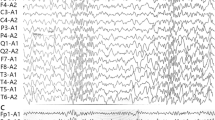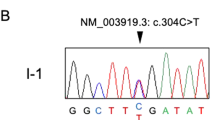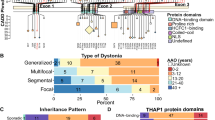Abstract
Dystonia is a movement disorder characterized by sustained or intermittent muscle contractions causing abnormal movements or postures. Several genetic causes of dystonia have been elucidated but genetic causes of dystonia specifically affecting females have not yet been described. In the present study, we investigated a large dystonia family from New Zealand in which only females were affected. They presented with a generalized form of the disorder including laryngeal, cervical, and arm dystonia. We found a novel, likely disease-causing, three base-pair deletion (c.443_445delGAG, p.Ser148del) in ATP1A3 in this family by combining genome and exome sequencing. Mutations in ATP1A3 have previously been linked to rapid-onset dystonia-parkinsonism (RDP), alternating hemiplegia of childhood (AHC), and CAPOS syndrome. Therefore, we re-examined our patients with a specific focus on typical symptoms of these conditions. It turned out that all patients reported a rapid onset of dystonic symptoms following a trigger suggesting a diagnosis of RDP. Notably, none of the patients showed clear symptoms of parkinsonism or symptoms specific for AHC or CAPOS. The ATP1A3 gene is located on chromosome 19q13.2, thus, providing no obvious explanation for the preponderance to affect females. Interestingly, we also identified one unaffected male offspring carrying the p.Ser148del mutation suggesting reduced penetrance of this mutation, a phenomenon that has also been observed for other RDP-causing mutations in ATP1A3. Although phenotypic information in this family was initially incomplete, the identification of the p.Ser148del ATP1A3 mutation elicited clinical re-examination of patients subsequently allowing establishing the correct diagnosis, a phenomenon known as “reverse phenotyping”.

Similar content being viewed by others
References
Albanese A, Bhatia K, Bressman SB, Delong MR, Fahn S, Fung VS, Hallett M, Jankovic J, Jinnah HA, Klein C, Lang AE, Mink JW, Teller JK (2013) Phenomenology and classification of dystonia: a consensus update. Mov Disord 28:863–873
Bourgeois M, Aicardi J, Goutieres F (1993) Alternating hemiplegia of childhood. J Pediatr 122:673–679
Brashear A, Cook JF, Hill DF, Amponsah A, Snively BM, Light L, Boggs N, Suerken CK, Stacy M, Ozelius L, Sweadner KJ, McCall WV (2012) Psychiatric disorders in rapid-onset dystonia-parkinsonism. Neurology 79:1168–1173
Brashear A, Dobyns WB, de Carvalho Aguiar P, Borg M, Frijns CJ, Gollamudi S, Green A, Guimaraes J, Haake BC, Klein C, Linazasoro G, Munchau A, Raymond D, Riley D, Saunders-Pullman R, Tijssen MA, Webb D, Zaremba J, Bressman SB, Ozelius LJ (2007) The phenotypic spectrum of rapid-onset dystonia-parkinsonism (RDP) and mutations in the ATP1A3 gene. Brain 130:828–835
de Carvalho Aguiar P, Sweadner KJ, Penniston JT, Zaremba J, Liu L, Caton M, Linazasoro G, Borg M, Tijssen MA, Bressman SB, Dobyns WB, Brashear A, Ozelius LJ (2004) Mutations in the Na+/K+ -ATPase alpha3 gene ATP1A3 are associated with rapid-onset dystonia parkinsonism. Neuron 43:169–175
Demos MK, van Karnebeek CD, Ross CJ, Adam S, Shen Y, Zhan SH, Shyr C, Horvath G, Suri M, Fryer A, Jones SJ, Friedman JM (2014) A novel recurrent mutation in ATP1A3 causes CAPOS syndrome. Orphanet J Rare Dis 9:15
Gilissen C, Hoischen A, Brunner HG, Veltman JA (2011) Unlocking Mendelian disease using exome sequencing. Genome Biol 12:228
Heinzen EL, Arzimanoglou A, Brashear A, Clapcote SJ, Gurrieri F, Goldstein DB, Johannesson SH, Mikati MA, Neville B, Nicole S, Ozelius LJ, Poulsen H, Schyns T, Sweadner KJ, van den Maagdenberg A, Vilsen B (2014) Distinct neurological disorders with ATP1A3 mutations. Lancet Neurol 13:503–514
Heinzen EL, Swoboda KJ, Hitomi Y, Gurrieri F, Nicole S, de Vries B, Tiziano FD, Fontaine B, Walley NM, Heavin S, Panagiotakaki E, Fiori S, Abiusi E, Di Pietro L, Sweney MT, Newcomb TM, Viollet L, Huff C, Jorde LB, Reyna SP, Murphy KJ, Shianna KV, Gumbs CE, Little L, Silver K, Ptacek LJ, Haan J, Ferrari MD, Bye AM, Herkes GK, Whitelaw CM, Webb D, Lynch BJ, Uldall P, King MD, Scheffer IE, Neri G, Arzimanoglou A, van den Maagdenberg AM, Sisodiya SM, Mikati MA, Goldstein DB (2012) De novo mutations in ATP1A3 cause alternating hemiplegia of childhood. Nat Genet 44:1030–1034
Kamm C, Fogel W, Wachter T, Schweitzer K, Berg D, Kruger R, Freudenstein D, Gasser T (2008) Novel ATP1A3 mutation in a sporadic RDP patient with minimal benefit from deep brain stimulation. Neurology 70:1501–1503
Kramer PL, Mineta M, Klein C, Schilling K, de Leon D, Farlow MR, Breakefield XO, Bressman SB, Dobyns WB, Ozelius LJ, Brashear A (1999) Rapid-onset dystonia-parkinsonism: linkage to chromosome 19q13. Ann Neurol 46:176–182
Lohmann K, Klein C (2013) Genetics of dystonia: what’s known? What’s new? What’s next? Mov Disord 28:899–905
Lohmann K, Klein C (2014) Next Generation Sequencing and the Future of Genetic Diagnosis. Neurotherapeutics 11:699–707
Nicolaides P, Appleton RE, Fryer A (1996) Cerebellar ataxia, areflexia, pes cavus, optic atrophy, and sensorineural hearing loss (CAPOS): a new syndrome. J Med Genet 33:419–421
Rosewich H, Baethmann M, Ohlenbusch A, Gartner J, Brockmann K (2014) A novel ATP1A3 mutation with unique clinical presentation. J Neurol Sci 341:133–135
Rosewich H, Ohlenbusch A, Huppke P, Schlotawa L, Baethmann M, Carrilho I, Fiori S, Lourenco CM, Sawyer S, Steinfeld R, Gartner J, Brockmann K (2014) The expanding clinical and genetic spectrum of ATP1A3-related disorders. Neurology 82:945–955
Rosewich H, Thiele H, Ohlenbusch A, Maschke U, Altmuller J, Frommolt P, Zirn B, Ebinger F, Siemes H, Nurnberg P, Brockmann K, Gartner J (2012) Heterozygous de-novo mutations in ATP1A3 in patients with alternating hemiplegia of childhood: a whole-exome sequencing gene-identification study. Lancet Neurol 11:764–773
Roubergue A, Roze E, Vuillaumier-Barrot S, Fontenille MJ, Meneret A, Vidailhet M, Fontaine B, Doummar D, Philibert B, Riant F, Nicole S (2013) The multiple faces of the ATP1A3-related dystonic movement disorder. Mov Disord 28:1457–1459
Steeves TD, Day L, Dykeman J, Jette N, Pringsheim T (2012) The prevalence of primary dystonia: a systematic review and meta-analysis. Mov Disord 27:1789–1796
Wang K, Li M, Hakonarson H (2010) ANNOVAR: functional annotation of genetic variants from high-throughput sequencing data. Nucleic Acids Res 38:e164
Westenberger A, Rosales RL, Heinitz S, Freimann K, Lee LV, Jamora RD, Ng AR, Domingo A, Lohmann K, Walter U, Golnitz U, Rolfs A, Nagel I, Gillessen-Kaesbach G, Siebert R, Dressler D, Klein C (2013) X-linked Dystonia-Parkinsonism manifesting in a female patient due to atypical turner syndrome. Mov Disord 28:675–678
Acknowledgments
This study was supported by intramural funding from the University of Luebeck.
Conflicts of interest
On behalf of all authors, the corresponding author states that there is no conflict of interest.
Ethical standards
All patients and controls provided written informed consent and the local ethics committee approved the study which has been performed in accordance with the ethical standards laid down in the 1964 Declaration of Helsinki and its later amendments.
Author information
Authors and Affiliations
Corresponding author
Additional information
R. Wilcox and I. Brænne contributed equally to this study.
Electronic supplementary material
Below is the link to the electronic supplementary material.
415_2014_7547_MOESM1_ESM.mp4
Video legend: The video demonstrates the presence of generalized dystonia in L4007. Spasmodic dysphonia slightly improves due to a sensory trick. The patient is mainly affected by dystonia of the upper half of the body (MP4 10931 kb).
Rights and permissions
About this article
Cite this article
Wilcox, R., Brænne, I., Brüggemann, N. et al. Genome sequencing identifies a novel mutation in ATP1A3 in a family with dystonia in females only. J Neurol 262, 187–193 (2015). https://doi.org/10.1007/s00415-014-7547-9
Received:
Revised:
Accepted:
Published:
Issue Date:
DOI: https://doi.org/10.1007/s00415-014-7547-9




